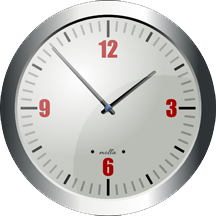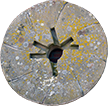On her way from her ten o'clock to her eleven, Lisa stopped by Mike's office to use his phone to check her messages. After the sixth message, she hung up — there were too many, and she couldn't do anything about them until 5 PM anyway. She wondered how she could ever get anything done.
 Lisa is caught in meeting madness. Every day, her backlog of To-Do's builds, as she sits in one meeting after another. To do any work at all, she has to start before 6 AM, or stay until 8 PM. Neither is possible.
Lisa is caught in meeting madness. Every day, her backlog of To-Do's builds, as she sits in one meeting after another. To do any work at all, she has to start before 6 AM, or stay until 8 PM. Neither is possible.
Lisa isn't the source of the problem — many of her meetings are mandatory. Rather, the problem is organizational. Many of us have days packed full of meetings, including the working lunch, the power breakfast — even the working dinner.
If you lead an organization, and people are mired in meeting madness, you can end it. Here are a few tips that can free everyone to finally get some work done.
- Focus the agenda
- Make sure that every invitee has a keen interest in every agenda item. Items that interest only some of the attendees belong in another meeting. Move FYIs to email.
- Start on time
- If you lead an organization,
and people are mired
in meeting madness,
you can end it - If some people are late, cancel immediately. Waiting around for someone wastes everyone's time, and if you can start without someone, why were they invited in the first place?
- Start at ten past the hour — or later
- For some reason, we're unable to end meetings at ten minutes before the hour, but if we start at ten past, everything somehow gets done. Agreeing to start all meetings at ten past (or later) gives everyone a chance to check messages, make phone calls, or just take a break. Start short meetings even later.
- Have enough conference rooms
- If conference rooms are scarce, people schedule weekly meetings just to hold onto their conference rooms. Make sure that there are so many conference rooms that one or two good ones are always available. You'll make up for remodeling costs by eliminating meetings.
- Eliminate lunch meetings
- People need lunch hours. Most of us are more productive if we've had a decent break. Working through lunch is neither work nor lunch.
- Split long meetings
- If you expect a meeting to run long, split it into two, separated by a long break, to give people a chance to deal with accumulating To-Do's. Tying people up for too long is an expensive hindrance to those who need their attention.
We have so many meetings, in part, because people are hard to find. And they're hard to find, in part, because we have so many meetings. To end this cycle, don't convene a meeting to discuss it. Just end it. ![]() Top
Top ![]() Next Issue
Next Issue
Are your projects always (or almost always) late and over budget? Are your project teams plagued by turnover, burnout, and high defect rates? Turn your culture around. Read 52 Tips for Leaders of Project-Oriented Organizations, filled with tips and techniques for organizational leaders. Order Now!
For other tips for making meetings more effective, see "First Aid for Painful Meetings," Point Lookout for October 24, 2001.
Your comments are welcome
Would you like to see your comments posted here? rbrenaXXxGCwVgbgLZDuRner@ChacDjdMAATPdDNJnrSwoCanyon.comSend me your comments by email, or by Web form.About Point Lookout
 Thank you for reading this article. I hope you enjoyed it and
found it useful, and that you'll consider recommending it to a friend.
Thank you for reading this article. I hope you enjoyed it and
found it useful, and that you'll consider recommending it to a friend.
This article in its entirety was written by a human being. No machine intelligence was involved in any way.
Point Lookout is a free weekly email newsletter. Browse the archive of past issues. Subscribe for free.
Support Point Lookout by joining the Friends of Point Lookout, as an individual or as an organization.
Do you face a complex interpersonal situation? Send it in, anonymously if you like, and I'll give you my two cents.
Related articles
More articles on Personal, Team, and Organizational Effectiveness:
 Take Regular Temperature Readings
Take Regular Temperature Readings- Team interactions are unimaginably complex. To avoid misunderstandings, offenses, omissions, and mistaken
suppositions, teams need open communications. But no one has a full picture of everything that's happening.
The Temperature Reading is a tool for surfacing hidden and invisible information, puzzles, appreciations,
frustrations, and feelings.
 How We Avoid Making Decisions
How We Avoid Making Decisions- When an important item remains on our To-Do list for a long time, it's possible that we've found ways
to avoid facing it. Some of the ways we do this are so clever that we may be unaware of them. Here's
a collection of techniques we use to avoid engaging difficult problems.
 Some Hidden Costs of Business Fads
Some Hidden Costs of Business Fads- Adopting business fads is an expensive organizational pattern, with costs that extend beyond what can
be measured by the chart of accounts most organizations use. Here are some examples of the hidden costs
of business fads.
 Personal Feasibility Decisions
Personal Feasibility Decisions- When considering whether to exploit a rare but desirable opportunity, there is a risk that desire can
overcome good sense. Having at hand a predefined framework for making such decisions reduces the risk
of blundering by acting in haste.
 Red Team Reviews of Uphill Briefings
Red Team Reviews of Uphill Briefings- In preparing for uphill briefings, briefers can benefit from preliminary reviews. When we review the
briefing early in development, the briefing team can address vulnerabilities and exploit opportunities.
A Red Team review is one style of preliminary review.
See also Personal, Team, and Organizational Effectiveness for more related articles.
Forthcoming issues of Point Lookout
 Coming October 1: On the Risks of Obscuring Ignorance
Coming October 1: On the Risks of Obscuring Ignorance- A common dilemma in knowledge-based organizations: ask for an explanation, or "fake it" until you can somehow figure it out. The choice between admitting your own ignorance or obscuring it can be a difficult one. It has consequences for both the choice-maker and the organization. Available here and by RSS on October 1.
 And on October 8: Responding to Workplace Bullying
And on October 8: Responding to Workplace Bullying- Effective responses to bullying sometimes include "pushback tactics" that can deter perpetrators from further bullying. Because perpetrators use some of these same tactics, some people have difficulty employing them. But the need is real. Pushing back works. Available here and by RSS on October 8.
Coaching services
I offer email and telephone coaching at both corporate and individual rates. Contact Rick for details at rbrenaXXxGCwVgbgLZDuRner@ChacDjdMAATPdDNJnrSwoCanyon.com or (650) 787-6475, or toll-free in the continental US at (866) 378-5470.
Get the ebook!
Past issues of Point Lookout are available in six ebooks:
- Get 2001-2 in Geese Don't Land on Twigs (PDF, )
- Get 2003-4 in Why Dogs Wag (PDF, )
- Get 2005-6 in Loopy Things We Do (PDF, )
- Get 2007-8 in Things We Believe That Maybe Aren't So True (PDF, )
- Get 2009-10 in The Questions Not Asked (PDF, )
- Get all of the first twelve years (2001-2012) in The Collected Issues of Point Lookout (PDF, )
Are you a writer, editor or publisher on deadline? Are you looking for an article that will get people talking and get compliments flying your way? You can have 500-1000 words in your inbox in one hour. License any article from this Web site. More info
Follow Rick
Recommend this issue to a friend
Send an email message to a friend
rbrenaXXxGCwVgbgLZDuRner@ChacDjdMAATPdDNJnrSwoCanyon.comSend a message to Rick
![]() A Tip A Day feed
A Tip A Day feed
![]() Point Lookout weekly feed
Point Lookout weekly feed
 My blog, Technical Debt for Policymakers, offers
resources, insights, and conversations of interest to policymakers who are concerned with managing
technical debt within their organizations. Get the millstone of technical debt off the neck of your
organization!
My blog, Technical Debt for Policymakers, offers
resources, insights, and conversations of interest to policymakers who are concerned with managing
technical debt within their organizations. Get the millstone of technical debt off the neck of your
organization!- Your stuff is brilliant! Thank you!
- You and Scott Adams both secretly work here, right?
- I really enjoy my weekly newsletters. I appreciate the quick read.
- A sort of Dr. Phil for Management!
- …extremely accurate, inspiring and applicable to day-to-day … invaluable.
- More
